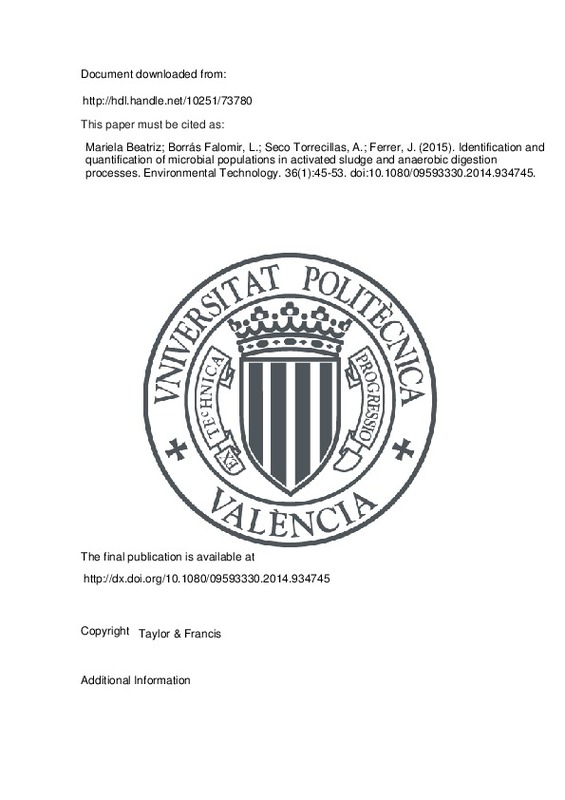JavaScript is disabled for your browser. Some features of this site may not work without it.
Buscar en RiuNet
Listar
Mi cuenta
Estadísticas
Ayuda RiuNet
Admin. UPV
Identification and quantification of microbial populations in activated sludge and anaerobic digestion processes
Mostrar el registro sencillo del ítem
Ficheros en el ítem
| dc.contributor.author | Reyes Sosa, Mariela Beatriz
|
es_ES |
| dc.contributor.author | Borrás Falomir, Luis
|
es_ES |
| dc.contributor.author | Seco Torrecillas, Aurora
|
es_ES |
| dc.contributor.author | FERRER, J.
|
es_ES |
| dc.date.accessioned | 2016-11-10T10:39:48Z | |
| dc.date.available | 2016-11-10T10:39:48Z | |
| dc.date.issued | 2015-01-02 | |
| dc.identifier.issn | 0959-3330 | |
| dc.identifier.uri | http://hdl.handle.net/10251/73780 | |
| dc.description.abstract | Eight different phenotypes were studied in an activated sludge process (AeR) and anaerobic digester AnD) in a full-scale wastewater treatment plant by means of fluorescent in situ hybridization (FISH) and automated FISH quantification software. The phenotypes were ammonia-oxidizing bacteria, nitrite-oxidizing bacteria, denitrifying bacteria, phosphate-accumulating organisms (PAO), glycogen-accumulating organisms (GAO), sulphate-reducing bacteria (SRB), methanotrophic bacteria and methanogenic archaea. Some findings were unexpected: (a) Presence of PAO, GAO and denitrifiers in the AeR possibly due to unexpected environmental conditions caused by oxygen deficiencies or its ability to survive aerobically; (b) presence of SRB in the AeR due to high sulphate content of wastewater intake and possibly also due to digested sludge being recycled back into the primary clarifier; (c) presence of methanogenic archaea in the AeR, which can be explained by the recirculation of digested sludge and its ability to survive periods of high oxygen levels; (d) presence of denitrifying bacteria in the AnD which cannot be fully explained because the nitrate level in the AnD was not measured. However, other authors reported the existence of denitrifiers in environments where nitrate or oxygen was not present suggesting that denitrifiers can survive in nitrate-free anaerobic environments by carrying out low-level fermentation; (e) the results of this paper are relevant because of the focus on the identification of nearly all the significant bacterial and archaeal groups of microorganisms with a known phenotype involved in the biological wastewater treatment. | es_ES |
| dc.description.sponsorship | This study was realized with support from the Universitat Politecnica de Valencia, Universitat de Valencia and CONACYT (National Council of Science and Technology of Mexico). | en_EN |
| dc.language | Inglés | es_ES |
| dc.publisher | Taylor & Francis | es_ES |
| dc.relation.ispartof | Environmental Technology | es_ES |
| dc.rights | Reserva de todos los derechos | es_ES |
| dc.subject | Identification and quantification of microbial populations | es_ES |
| dc.subject | Activated sludge | es_ES |
| dc.subject | Anaerobic digestion | es_ES |
| dc.subject.classification | TECNOLOGIA DEL MEDIO AMBIENTE | es_ES |
| dc.title | Identification and quantification of microbial populations in activated sludge and anaerobic digestion processes | es_ES |
| dc.type | Artículo | es_ES |
| dc.identifier.doi | 10.1080/09593330.2014.934745 | |
| dc.rights.accessRights | Abierto | es_ES |
| dc.contributor.affiliation | Universitat Politècnica de València. Escuela Técnica Superior de Ingenieros de Caminos, Canales y Puertos - Escola Tècnica Superior d'Enginyers de Camins, Canals i Ports | es_ES |
| dc.contributor.affiliation | Universitat Politècnica de València. Instituto Universitario de Ingeniería del Agua y del Medio Ambiente - Institut Universitari d'Enginyeria de l'Aigua i Medi Ambient | es_ES |
| dc.description.bibliographicCitation | Reyes Sosa, MB.; Borrás Falomir, L.; Seco Torrecillas, A.; Ferrer, J. (2015). Identification and quantification of microbial populations in activated sludge and anaerobic digestion processes. Environmental Technology. 36(1):45-53. doi:10.1080/09593330.2014.934745 | es_ES |
| dc.description.accrualMethod | S | es_ES |
| dc.relation.publisherversion | http://dx.doi.org/10.1080/09593330.2014.934745 | es_ES |
| dc.description.upvformatpinicio | 45 | es_ES |
| dc.description.upvformatpfin | 53 | es_ES |
| dc.type.version | info:eu-repo/semantics/publishedVersion | es_ES |
| dc.description.volume | 36 | es_ES |
| dc.description.issue | 1 | es_ES |
| dc.relation.senia | 299221 | es_ES |
| dc.contributor.funder | Universitat Politècnica de València | es_ES |
| dc.contributor.funder | Consejo Nacional de Ciencia y Tecnología, México | es_ES |
| dc.contributor.funder | Universitat de València | es_ES |







![[Cerrado]](/themes/UPV/images/candado.png)

